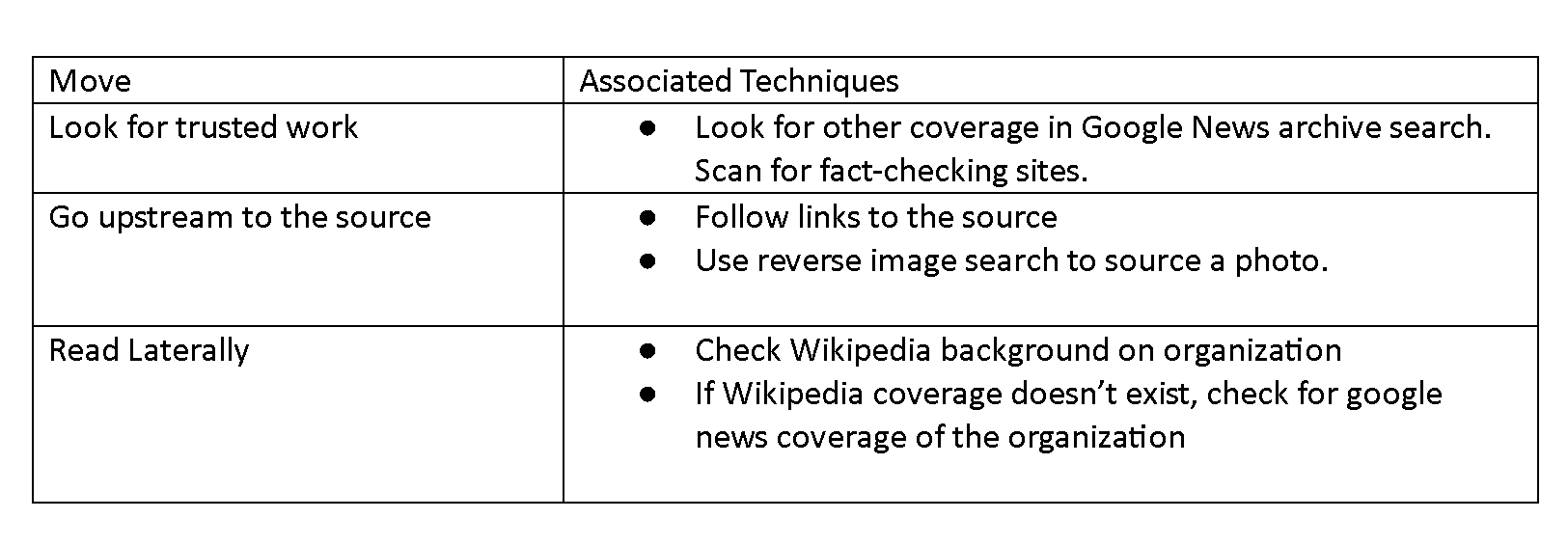I worked with Civix, a Canadian non-profit, to do a series of videos showing students basic web techniques for source verification and contextualization. I had boiled it down to four scripts running six minutes apiece; Civix and their production partner managed to cut them down to about three minutes each after filming.
Here’s the introduction, which features a bit of narrative around Sam Wineburg and Sarah McGrew’s work and how it informs what we do:
This study came out after Web Literacy for Student Fact-Checkers, but it’s been one of the biggest influences on the continued development of our curriculum. It’s hard to summarize a study in six minutes — and my six minutes were cut down further by editing to three — but I think the presentation of the study survives here.
The second video encourages students to investigate the source before they invest time in reading it (with a heavy lean on Wikipedia as a first stop).
This is one example of how we’ve honed what we teach over the past 18 months. Initially, we gave students a method for searching for information on a site by doing a search like [[dailywire.com -site:dailywire.com]]. This finds coverage of a site that is not from the site itself.
It’s a great search strategy! And people loved it in workshops — the secret language of search!
But when I’d talk to faculty who were in the workshops a few months later they would say — hey, how’d that trick go again? I want to show it to my students.
Maybe I worry too much, but my guess is if the faculty member has to ask me for the trick two months later (“It’s site something something, or negative site, right?”) then I doubt their students are going to hang on to it either. So we went from the researcher-like [[example.com -site:example.com]] to “just add Wikipedia to the omnibar.”
It’s the same with a lot of our techniques. We started with a book of more than two dozen verification techniques. We’ve got the core down to five starter techniques associated with three moves.

It reminds me of the old joke about the student who goes up to the expert and asks them “How long did it take you to write that speech?”
“Ten years.”
It’s not a funny joke, but it’s applicable. Teaching this to faculty constantly over the past 18 months has boiled this down, down, down.
Video three reminds students to find the original source of reporting.
There’s so much more to say about this — of course in some cases intermediate reporting sources add additional verification or analysis, etc, etc. But the social web often pushes us low-quality re-reporting of higher quality originals, and the propaganda techniques of leveling and sharpening distort original stories along the way. Finding the source is an essential skill.
Finally a video on finding trusted sources:
For some, the “rely on established sources” piece of this is going to be the most controversial bit of advice. It became a bit more highlighted in the editing here than in my original script. When we drop this into a longer sequence of classes we have discussions about the necessity of non-established sources to a dynamic ecosystem, and about the worry that algorithms can filter out significant minority points of view.
But I actually like the video as it came out here. When it comes to news reporting (which is the subject of the Civix/NewsWise videos here) we want publications with a history we can evaluate, and reporters who have either learned their craft from journalistic culture or long experience. That can come from excellent non-profits like ProPublica, or for-profits like the LA Times. Even advocacy journalism like David Corn at Mother Jones. But that culture takes time to develop, and the truth is that older publications often have a level of rigor on this that newer online initiatives can’t touch. If I have to choose between sourcing a fact to hip new online mag Babel or my hometown newspaper, I’m going to choose my hometown newspaper.
The bigger point in this video is the “broadening” technique that gets students out of the habit of just reading the version of the story that comes to them. The “Search Google News” habit reminds people when they learn of an interesting story through their feed they are not required to read that version of the story. The can go back and fish in Google News for a higher quality story on the same topic before they invest their time.
This is a simple realization that most people still haven’t had yet. As I say — it’s the internet — you’re not stuck with that one story that comes to you. By going out and actively choosing a better story you will not only filter out false stories but also see the variety of ways an event is being covered.
Anyway, thanks to the Civix people for some great work — we had a deal that I’d help out on the videos as long as I could sculpt them so they would be useful for our Digipo Initiative classes as well. It worked out great and we intend to use these in our own work. We hope you will too!
Leave a comment